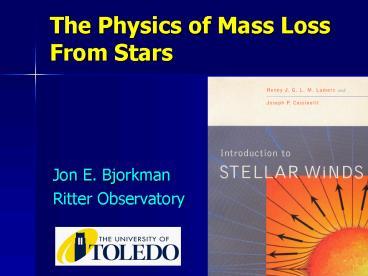The Physics of Mass Loss From Stars - PowerPoint PPT Presentation
1 / 40
Title: The Physics of Mass Loss From Stars
1
The Physics of Mass Loss From Stars
- Jon E. Bjorkman
- Ritter Observatory
2
Fluid Equations
- Continuity
- Momentum
- Energy (Dominated by Heating/Cooling)
- Equation of State
3
Wind Mechanisms
- Pressure-Driven
- Coronal Winds
- Wave-Driven
- Accoustic Waves
- Alfven Waves
- Rotationally-Driven
- Centrifugal
- Magneto-centrifugal
- Radiation-Driven
- Dust
- Continuum Opacity
- Spectral Lines
4
Stellar Mass Loss
- Hydrostatic (Isothermal) Atmosphere
- Outer Boundary Condition
- (almost) Zero Pressure
- Impossible to build Static Star
5
Isothermal Winds
- Wind Equation
- Combined momentum and continuity equations
- Critical Point
Pushing on flow moves rc inward
6
X-Type Solution Topology
Bondi 1952
7
Boundary Conditions
- Two point boundary value problem
- Stellar Surface
- ISM
- Mass Loss Rate
8
Stellar Outflow
Decreasing PISM
Increasing
9
Stellar Outflow
- As PISM decreases
- flow initially subsonic
- v0 increases gt mass loss increases
- outer boundary determines mass loss rate
- Until solution passes through critical point
- v0 now constant gt mass loss constant
- flow is choked
- termination shock matches PISM
- outer boundary determines shock location
- Conclude
- Mass loss determined by critical point location
10
Effect of External Forces
- Supersonic Momentum Deposition
- Increases terminal speed
- Mass loss unchanged
- Subsonic Momentum Deposition
- Moves critical point inward
- Increases mass loss
- May indirectly affect terminal speed
11
Continuum-Driven Winds
- Radiative Acceleration
- Wind Equation
- AGB Stars
- Dust condenses in outflow
12
Line-Driven Winds
- Sobolev Optical Depth
- Line acceleration
- Optically thin lines
- Optically thick lines
13
Line-Driven Winds
- Line Acceleration
- CAK parameterization
14
Line Force
Abbott 1980
Abbott 1982
15
Line-Driven Winds
- Wind Equation
16
Line-Driven Winds
- Wind Acceleration
- Subsonic
- 1 positive soln
- Sonic
- 1 positive soln
- Supersonic
- 2 positive solns
- Critical
- 1 positive soln
- Plus one more negative solution
17
Line-Driven Winds
Abbott 1980
18
CAK Critical Point Topology
- Quasi-Linearization
- Courant and Hilbert 1962
- Differentiate wind equation (so that it is linear
in the derivatives) - Wind Equation
19
CAK Critical Point Topology
- CAK critical point is X-type
Bjorkman 95
(D0)
20
Line-Driven Winds
- Mass Loss Rate
- At critical point
- flow speed speed of inward radiative-acoustic
wave (Abbott 1980) - Radiative force balances gravity (inertia)
- given yc, mass loss (r) is raised/lowered until
there are the correct number of thin lines
(Gayley 1995)
21
Line-Driven Winds
- Terminal Speed
- (formerly) optically thick lines gt G gt 1
- Provide acceleration in supersonic region
- Relative number of thick lines sets terminal
speed - Changes in line force (ionization shifts, d, etc)
alter terminal speed
22
Temperature Dependence
- Dominant Driving Ions
- O Stars
- CNO
- B Stars
- Fe group
Abbott 1982
23
Bi-stable Winds
- Ionization shifts alter driving lines
- Mass increases discontinuously
- Terminal speed drops
- Caused by change of Fe III ionization (Vink, de
Koter, Lamers 1999)
Pauldrach Puls 1990 Lamers Pauldrach 1991
24
Bi-Stable Winds
- Observed Terminal Speeds
Crowther, Lennon, Walborn 06 see also Evans et
al. 04, and Trundle et al. 04
Lamers, Snow, Lindholm 95 Kudritzki Puls 00
25
Weak Line-Driven Winds
- Breakdown of CAK parameterization
- Wind requires at least one optically thick line
- Abbott 1979
- Babel 1996
Abbott 1979
26
Weak Line-Driven Winds
- Gas not well coupled to driving ions
- Ion runaway heating
- Springmann Pauldrach 1992
- Gayley Owocki 1994
- Multicomponent Winds
- Babel 1995
- Krticka Kubat 2000, 2001
- Detailed multicomponent NLTE Model
- Krticka Kubat 2004
- Wind terminal speed is lowered
- removes discrepancies with observations
27
Metallicity Dependence
- Wind driven by metals
- Lower mass loss at low Z
- Vink et al. 2001
- See also Abbott 1982 Puls et al. 2000 Kudritzki
2002 - Lower terminal speed
- Garmany Conti 85 Prinja 87 Leitherer et al.
92
28
High Mass Loss
- Wind Momentum
- Single Scattering Limit
- Wind momentum problem (Barlow et al. 1981)
- Photon Tiring Limit
- Owocki Gayley 1997
29
Multiple Scattering
Abbott Lucy 1985
30
Multiple Scattering
- Theoretical performance factor
- Gayley, Owocki, Cranmer 1995
- Momentum problem is really an opacity problem
- must fill entire spectral region with lines
- Requires ionization stratification
- Lucy Abbott 93, Springmann 94,
- Yes, but ionization is tricky
- Schmutz 91, 94, 97 Shaerer and Schmutz 94
31
Line Driven Winds withMultiple Scattering
- Monte Carlo RT Simulation
- Kurucz line list (106 lines)
- Sample photon scatterings
- Measure line acceleration
- Measure energy transfer from photons to wind
- Lucy Abbott (1993) method
- Assume velocity law
- Use energy conservation to find mass loss rate
32
Line Driven Winds withMultiple Scattering
- Schaerer Schmutz 1994 Kudritzki 2002
- Use depth-dependent k a
- solve wind dynamics, including critical point
- Mihaylov Bjorkman (2004)
- sample MC line forces in each cell
- Gives (Cf)i and ai
- Solve for yi and integrate wind velocity
- Map solution topology
33
Multiple Scattering
Mihaylov 04
34
Ionization Effects
Mihaylov 04
35
Continuum Driven Winds
- Basic Requirement
- Nugis Lamers (2002)
- used Fe-bump (OPAL opacities)
- At sonic point
- Opacity must increase outward
- Eddington factor G 1
36
OPAL Opacities
- Sonic Point
Nugis Lamers 02
37
NLTE rad-hydro WR Wind
Gfäfener Hamann 2005
38
NLTE rad-hydro WR Wind
Gfäfener Hamann 2005
39
Instabilities, Clumps Porosity
Shaviv 01
Shaviv 00
40
Acknowledments































